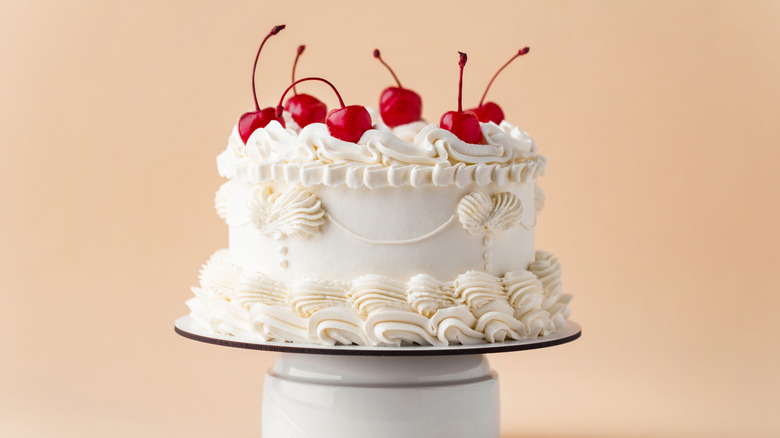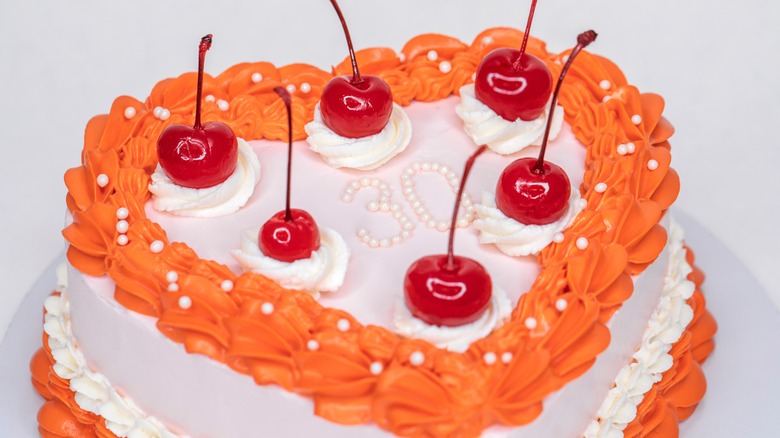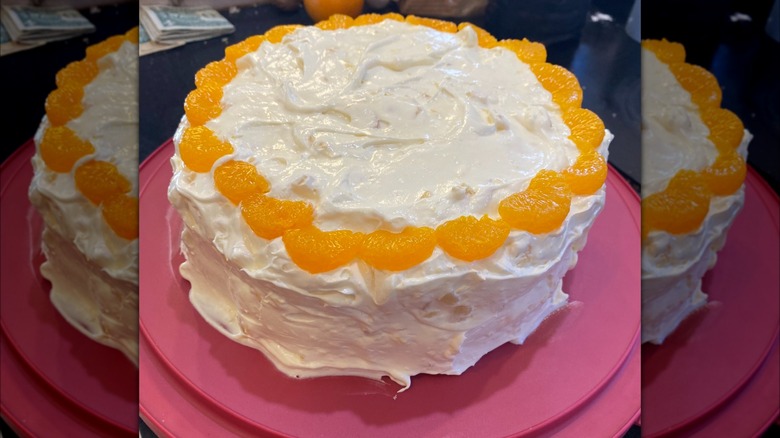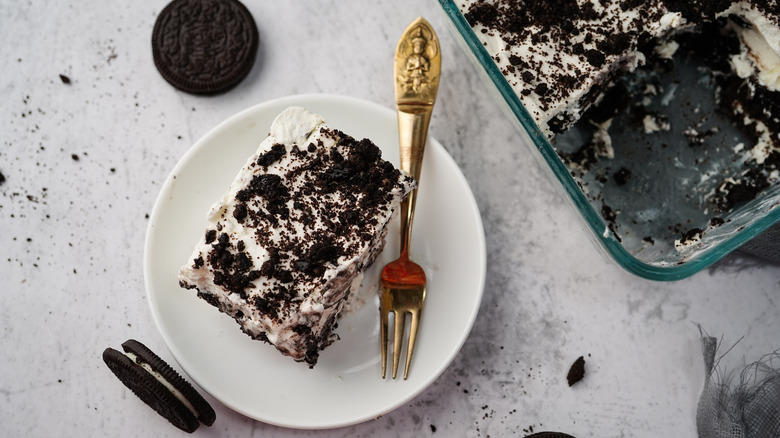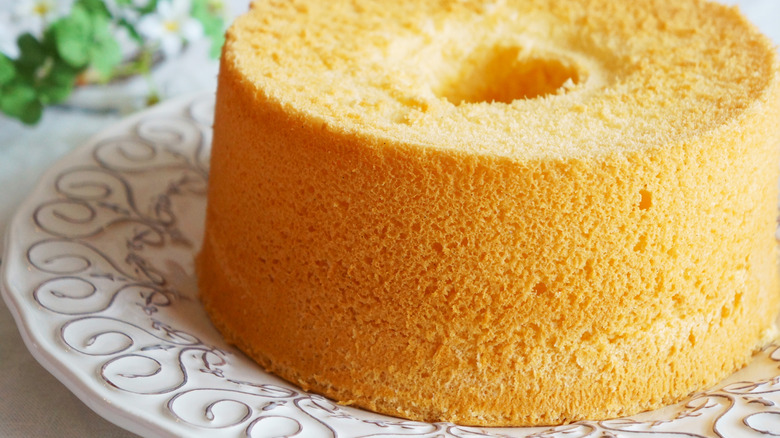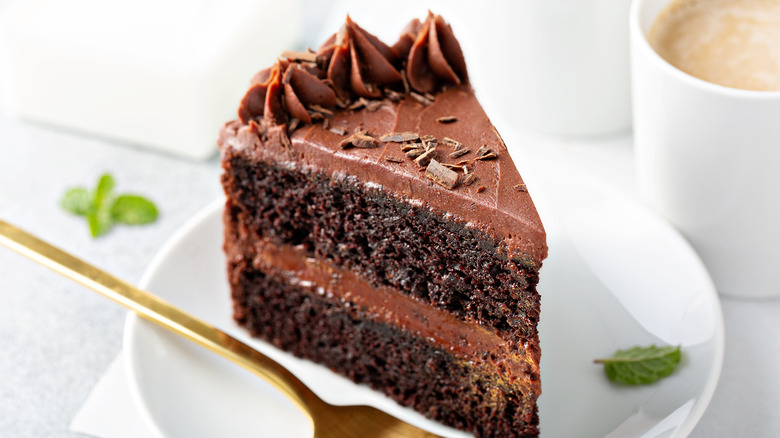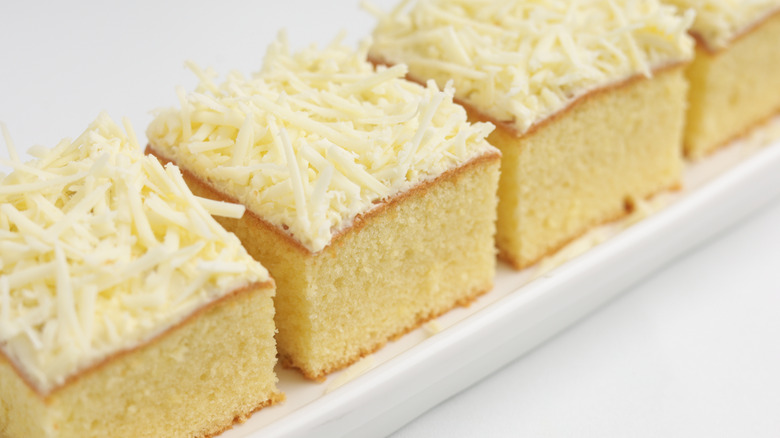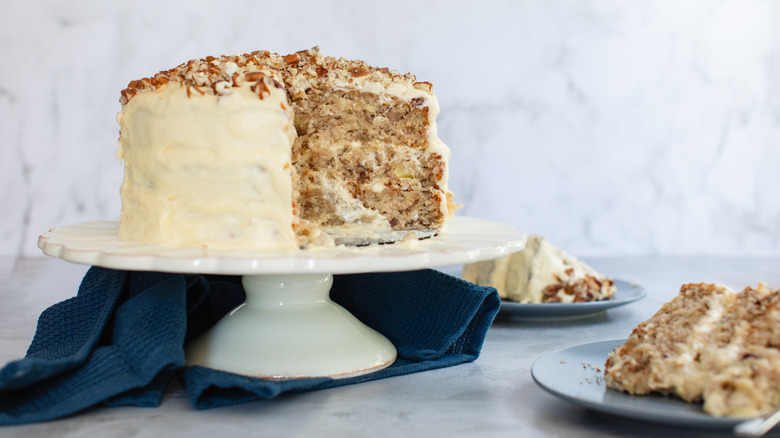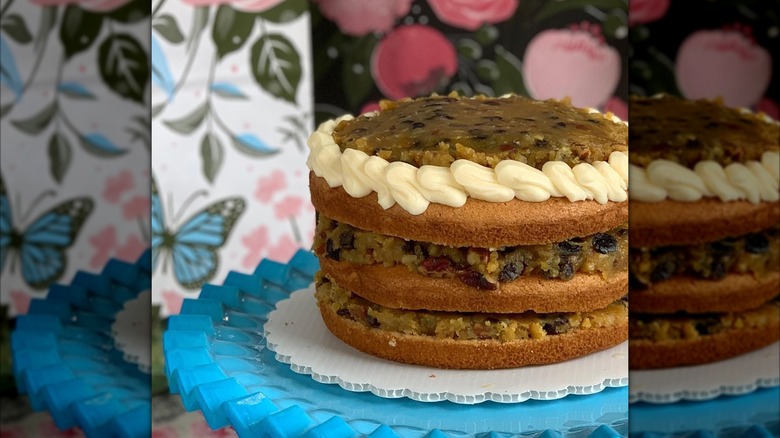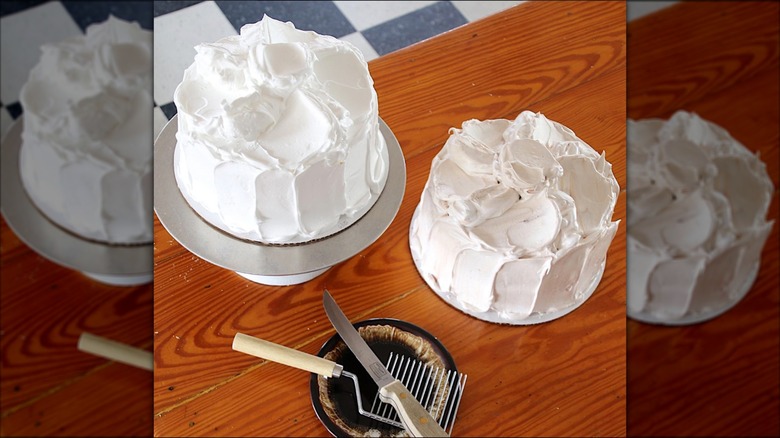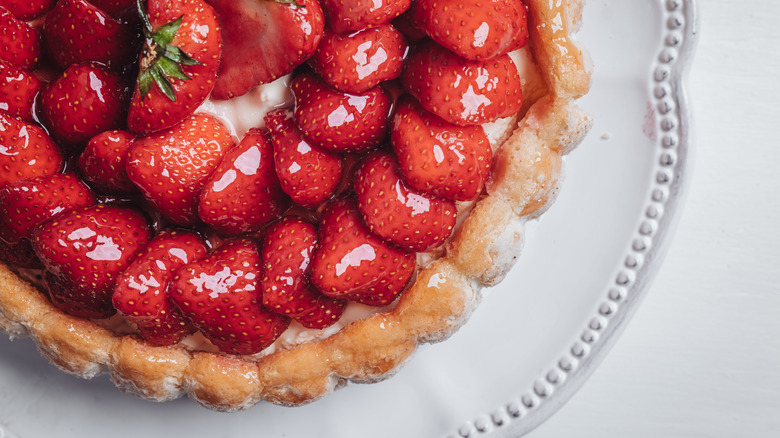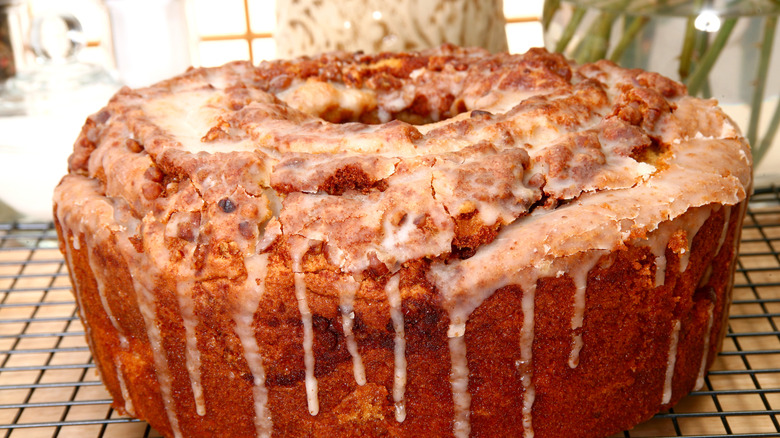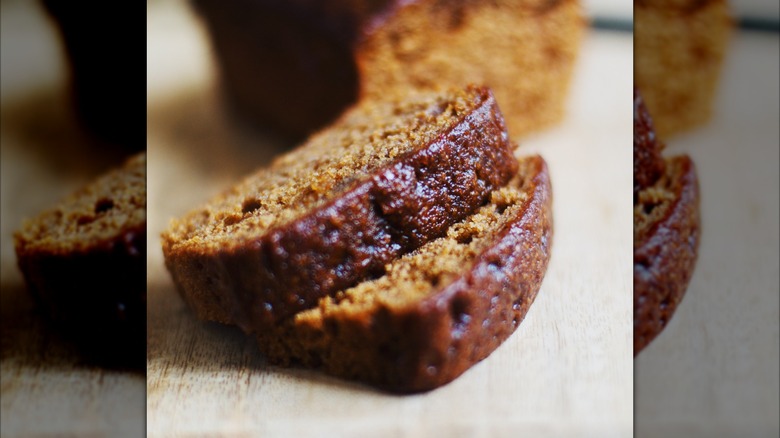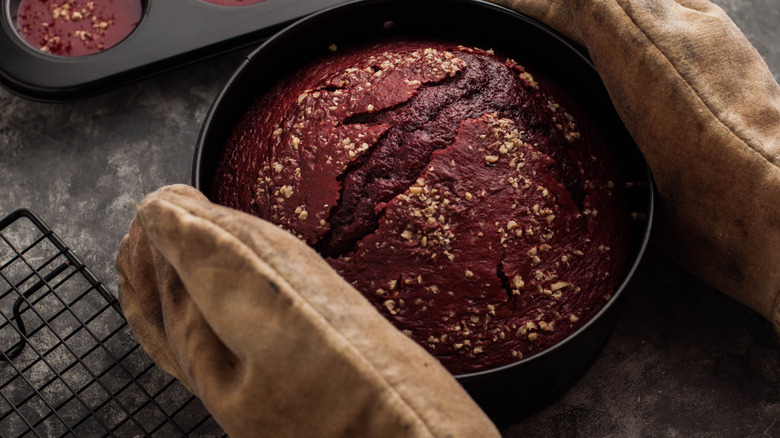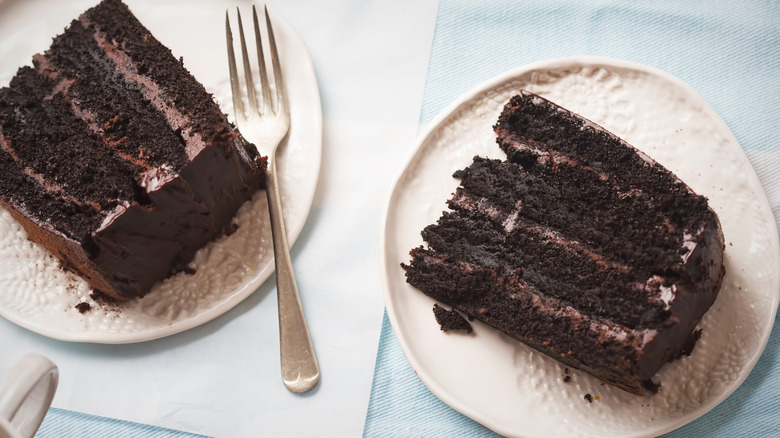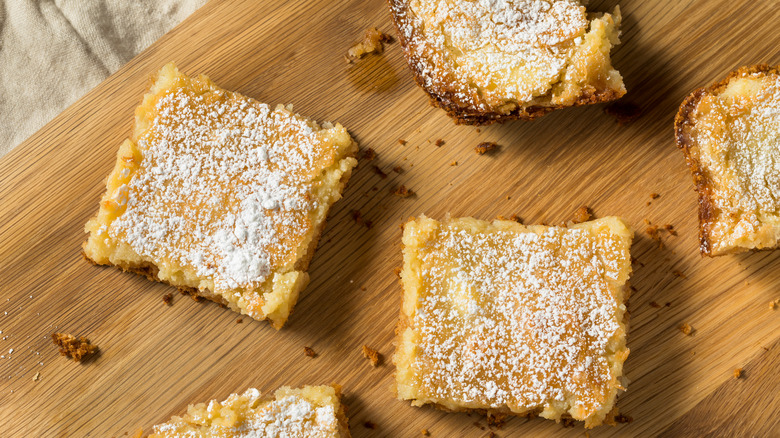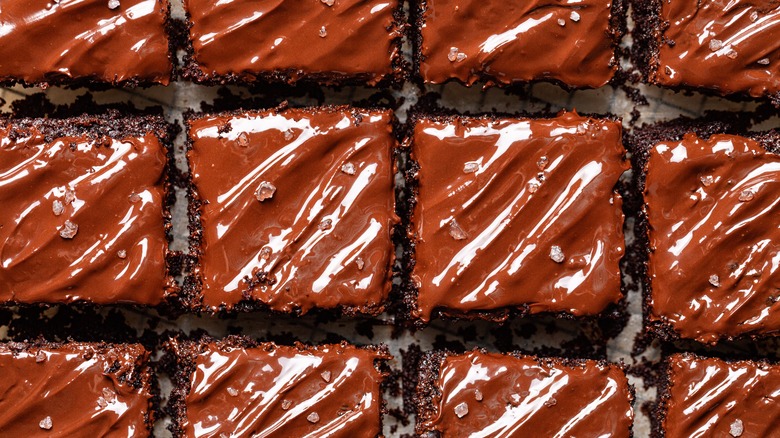16 Vintage Cakes You Need To Make
Food trends come and go, but some recipes are better left in the past. For some reason, our grandparents had a passion for combining the likes of bananas and ham slices, prawns and apples, Miracle Whip and pears, and a whole host of things with Jell-O. However, there are also some vintage recipes that really deserve a rebirth. Whether they originally came about due to creativity, ingenuity, or simply hard times, some of these recipes still have lots to offer modern diners beyond flavor, including affordability and convenience. This becomes clear when you look at long-standing vintage dinner staples and when you take a gander at various vintage cake recipes that have been lost to time.
Not convinced? Just take a look at the recent increased interest in vintage Lambeth cakes, which have gone viral on social media — and Lambeth cakes just scratch the surface. Here are 16 vintage cakes to consider for your next baking project.
Lambeth cakes
You might not recognize the name "Lambeth cakes," but you probably know exactly what we're talking about if we mention vintage-style heart cakes. These elaborate cakes feature extravagant piping and an extra-feminine look. They've appeared in music videos, popped up on social media, and even managed to spark controversy, with drama arising in the baking community when Walmart began offering its own take on the cakes.
While Lambeth-style cakes may be making a comeback, they're certainly nothing new. Originating in Europe, they were named after a famous baker and cookbook author named Joseph Lambeth and became particularly popular in the Victorian era. These cakes are mostly special due to their style, not their flavor or ingredients. They can come in just about any flavor you like, but they always feature that distinct exterior appearance.
These eye-catching cakes deserve their recent spot in the spotlight, and making one at home is the perfect excuse to try out your piping skills. No heart-shaped baking pan on hand? No worries. Lambeth cakes can technically be any shape or size; the "Lambeth" definition only strictly applies to the decorating style.
Million dollar cake
This vintage cake from the 20th century is the perfect, easy spring cake. While million dollar cake recipes can differ, they all include pineapple and typically result in a cake with a light, airy texture. Some recipes may instruct you to make the yellow cake from scratch, but you can easily use a boxed yellow cake mix. From there, you'll make a pineapple filling. Sometimes, boxed pudding is also used as a base for this filling. Generally, though, all recipes will have a cream cheese frosting, and you can expect to add mandarin oranges somewhere in the mix, too.
If you like a pineapple upside-down cake or a hummingbird cake — another vintage cake that has its roots in Jamaica but was popularized in the South — you'll likely enjoy a million dollar cake. Plus, it's one that even the most inexperienced bakers can take on if they follow a recipe that relies on a few shortcuts, such as boxed ingredients.
Icebox cake
An icebox cake is more like an ice cream cake or a dirt cake than an actual birthday cake. Oreo torte is a good comparison. Think of it a little like a dessert casserole. First popularized in the 1920s, making the cake involves layering a mix of ingredients in a casserole dish or similarly shaped vessel, popping it into the fridge (aka the icebox), and digging in once it's cold. Unsurprisingly, it's an excellent dessert for the summer.
Traditionally, the layers of an icebox cake are made up of some sort of thin cookie (Nabisco's Famous Chocolate Wafers were the go-to until Nabisco axed the cookies in 2023) and whipped cream. You can also add chocolate or fruit if desired. As the cake chills in the refrigerator, the cookies soften against the whipped cream, and as it all hardens together, it becomes sliceable for easy serving. However, don't expect this cake to slice perfectly. Like its sibling, the dirt cake, this is a cake you might want to eat with a spoon.
Chiffon cake
A chiffon cake can be likened to a sponge or angel cake, but it comes with a few key differences. A chiffon cake incorporates egg whites and cream of tartar as a leavening agent, but it also includes moisture and fat in the form of oil rather than butter.
That said, chiffon cake is still pretty similar to angel food cake. In fact, the creator of the chiffon cake, Harry Baker (yes, it's a fitting last name), was inspired by angel food cake when coming up with the recipe. His goal was to come up with a cake that would yield a slightly lighter crumb. While he achieved his goal and presented the chiffon cake in the 1920s, the cake didn't gain widespread recognition until the 1940s. This was when Baker sold his chiffon cake recipe to General Mills, which then published the recipe under the Betty Crocker brand. Today, you can find chiffon cake recipes that tweak the original with a variety of added flavors, such as lemon and chocolate.
Mayonnaise cake
This is one of those vintage recipes that may raise a few eyebrows. The previous generations were all about putting mayonnaise in odd places, including in their cake, and while that may sound disgusting at first, hear us out. Mayonnaise cake isn't a mayo-flavored confection. Instead, it's pretty much the same as a regular cake, except the mayonnaise lends the cake more moisture and fat (after all, at the end of the day, mayo is primarily just eggs and oil) rather than flavor.
Quite often, mayonnaise cakes have a rich chocolate taste. In some recipes, like this chocolate mayo cupcake recipe, the mayonnaise actually takes the place of eggs and oil. This is a nice nod to the origins of mayonnaise cake. It first became popular in the 1940s, when World War II rations made it difficult to secure both dairy and eggs. Mayonnaise brands consequently pushed mayo cake recipes as a solution for bakers seeking alternative ingredients.
Hot milk cake
Hot milk cake is a type of sponge cake that's surprisingly easy to make compared to some of its other spongy siblings. At the same time, it still offers a great level of flavor and versatility. You can find recipes for hot milk cake dating as far back as the early 1900s. Like so many other vintage sweet treats, the cake grew popular when wartime rations made ingredient-savvy and inexpensive recipes king. Hot milk cake could even be made using powdered milk rather than fresh milk, making it even more accessible to home bakers.
A hot milk cake requires, of course, hot milk combined with melted butter before being added to your basic mix of eggs, sugar, and dry ingredients like flour and a leavening agent. As mentioned, hot milk cake is incredibly versatile, meaning you can serve it plain like a regular sponge cake, frost it to present as a birthday cake, or even use it as the base for a Boston cream pie.
Hummingbird cake
The hummingbird cake is somewhat similar to the million dollar cake, containing both pineapple and cream cheese. However, it still has a few elements that help it stand out, including a unique past. The first known recipe for hummingbird cake was distributed by the Jamaica Tourist Board in the 1960s in an effort to drive visitors to the country. Originally known as the doctor bird cake, it incorporated some of the fruits grown in Jamaica and quickly gained traction in the American South, where the cake still retains some level of popularity today.
There are a few ingredients in a hummingbird cake that are crucial. Pineapple, bananas, pecans or walnuts, and cream cheese are all staples, with some recipes also calling for coconut. The resulting cake — nutty, fruity, and perfectly complemented by a cream cheese frosting — is incredibly moist and typically layered in threes for even more creamy goodness in every bite. Want to really go retro with this baking project? Use mayonnaise in the cake instead of oil.
Lane cake
Lane cake is the official state dessert of Alabama, and one taste is enough to understand why. The cake can be traced back to an 1898 baking competition, where Alabama native Emma Rylander Lane entered with the recipe and, of course, won. It features spongy layers intermixed with a filling that's made up of egg yolks, pecans, coconut, raisins, sugar, and a whole lot of alcohol.
When it comes to the alcohol in question, you can choose between brandy or bourbon. The only rule is that you use a lot, with one to three cups required per cake. The Lane cake's booziness is so well known that it's even mentioned in Harper Lee's "To Kill a Mockingbird." Some claim that the booze ensures the cake will remain good to eat for weeks, or even up to a month, much like fruit cake. Try making this cake and you'll quickly see why it was previously known as a "prize cake."
Lady Baltimore cake
This elegant-sounding cake has an appearance that matches its name, with layers of sponge sandwiched between incredibly shiny, stark-white icing. However, the Lady Baltimore cake isn't from Baltimore and there was no specific lady involved in its invention. Instead, the cake appeared in the American South in the early 1900s. It features chiffon cakes as its base with a filling of raisins and nuts, covered in boiled icing. Due to the lack of butter in the icing, the cake is typically more durable than others in hot weather, making it popular at somewhat fancier occasions in the South's harsh summer conditions.
Not familiar with boiled icing? It requires a little extra work than what might be required for a simple buttercream or cream cheese icing, but it's well worth the effort. The process involves boiling a sugar mixture on the stovetop, as well as whipping up some egg whites, and then combining the two. Do it all correctly, and you'll get a wonderfully fluffy, but surprisingly firm icing.
Charlotte Russe cake
No, we're not talking about the women's apparel chain. This is a fancy little cake with French origins but vintage appeal in the United States, becoming popular around the mid-20th century when many home cooks and bakers attempted international recipes in an effort to show off their worldly palates.
If you're not familiar with this cake, it really is something you might expect to see on "The Great British Baking Show." Ladyfingers, often brushed with some sort of alcohol, line a pan. Then, a whipped cream mousse filling made with gelatin is poured into the center. The cake chills to set, and the finished mousse can be topped with more whipped cream, fruit, or chocolate curls — whatever your heart desires. When you take the cake out of the fridge and pan, you're left with a showstopper that's just as pretty to look at as it is delicious to eat. If you try a Charlotte Russe recipe and find you like it, you may want to try making one of the other types of "Charlotte" cake, such as a Charlotte royale.
Sock-it-to-me cake
This cake's roots don't go as far back as some of the others on this list, but it's still nearing about 50 years old. Invented by Duncan Hines (yes, the boxed cake mix brand) in the 1970s, the recipe for a sock-it-to-me cake likely first appeared on the back of one of these boxes. As you could probably guess, this easy-to-make sweet treat starts with a box of cake mix — specifically, a yellow cake mix.
The cake mix is prepared as normal, with eggs, oil, and water. However, you'll also need to throw in a few extra ingredients, such as sour cream. Then, half the batter goes into a Bundt pan, where it's topped with a mixture of pecans, brown sugar, and cinnamon before you add the other half of the batter. After the cake is done, you can always apply a glaze. Otherwise, what you get is a very simple Bundt cake that benefits from the extra flavor and texture provided by the ribbon of pecans, cinnamon, and sugar in the middle. If you were looking for an old-fashioned cake that's simple, satisfying, and perfect with an after-dinner coffee — or even a morning sweet treat — you found it.
Tomato soup cake
Like mayonnaise cake, tomato soup cake is one of those vintage recipes that may initially spark skepticism. It doesn't sound exactly appetizing, but judging this cake by its cover (er, name) is a mistake. A product of the early 1900s, and promoted by Campbell's as a way to use its canned soup, tomato soup cake couldn't be any easier.
It requires just five ingredients – all of which are budget-friendly — and barely any baking know-how. All you need is a box of spice cake mix, a can of condensed tomato soup, water, eggs, and cream cheese frosting, if you want it. You mix all of the ingredients except for the icing together, bake it, and then apply the frosting.
Just like mayonnaise cake, a tomato soup cake doesn't carry the same flavor as its namesake. Instead, it simply tastes like a very moist spice cake. So, if you like the latter, there's a good chance that you'll like tomato soup cake, too.
Mahogany cake
We have the mahogany cake to thank for both modern red velvet and chocolate cakes. With its mahogany hue and mild chocolate flavor, mahogany cake was the predecessor to both sweet treats in the U.S., dating back to the 1800s. The use of vinegar in the recipe makes it similar to red velvet, but there are no ingredients that would give the cake a shockingly red finish. Likewise, the amount of chocolate used in the recipe ensures that the cake offers a chocolate flavor that's not overwhelmingly rich.
Traditionally, mahogany cake would be served topped with ermine frosting. This type of frosting is pretty easy for beginners. If you can make a roux, you can make ermine frosting, which comes together by cooking flour with sugar and milk and then combining it with butter. The final result can be likened to store-bought frosting in texture and flavor, providing an interesting alternative to your standard homemade buttercream.
Coca-Cola cake
Coca-Cola cake might be more familiar to you than some of the other vintage cakes on this list, thanks in part to Cracker Barrel, which added the cake to its menu in the late 1990s. The cake has been around since at least the 1950s, putting a unique spin on the traditional chocolate cake. Some recipes include marshmallows, with the icing also occasionally containing extra soda or nuts.
The cake is comparable to a Texas sheet cake, except for the fact that the latter contains no soda. Just like a mayonnaise cake and tomato cake, though, note that the trademark Coca-Cola flavor doesn't dominate the final result. This cake is all rich chocolate, all the time. From a practical perspective, it also makes sense why home bakers might've started adding fizzy soda to cakes as soda became more mainstream. The carbonation acts as a leavening agent, while the extra liquid adds moisture, which is always a plus for chocolate cake.
Gooey butter cake
Gooey butter cake is much simpler than some of the other, more extravagant cakes on this list, but what it lacks in pizzazz, it makes up for in, well, gooeyness. The cake is most often associated with St. Louis, where it originated. While the exact inventor is up for debate, one theory is that, like many good things, the first gooey butter cake was made completely by accident when a baker messed up their ingredient quantities. As the story goes, the inventor realized their good fortune, fine-tuned the recipe, and started selling their creation, after which other bakeries around the city followed suit.
If you're making your gooey butter cake from scratch, you'll need to start with a yeasted base. This is then topped with a gooey layer of cake. Alternatively, you can take the easier route of making the base from a cake mix and topping it with a cream cheese mixture.
Texas sheet cake
Texas sheet cake sometimes goes by the name Texas funeral cake, but you don't need to wait for someone to kick the bucket to indulge in this rich and decadent chocolate treat. To put it simply, the cake is a chocolate sheet cake topped with a fudgy, boiled icing that thickens as it cools.
Once the cake is complete, it's thin and rectangular and served in squares. Pecans are sometimes added for extra texture, but if you absolutely don't want to use the pecans, or if you'd like to swap the pecans for another nut, no one's going to force your hand. Some people also add miniature marshmallows to the top, similar to a Coca-Cola cake, though again, that's not the standard.
Recipes for the cake were circulating through the South as early as the 1930s. While some may say that Lady Bird Johnson — former First Lady and wife of President Lyndon B. Johnson — created the cake, that claim remains unproven. Regardless of who can claim this chocolate cake as their own invention, this is surely a cake that deserves a resurgence in popularity.
